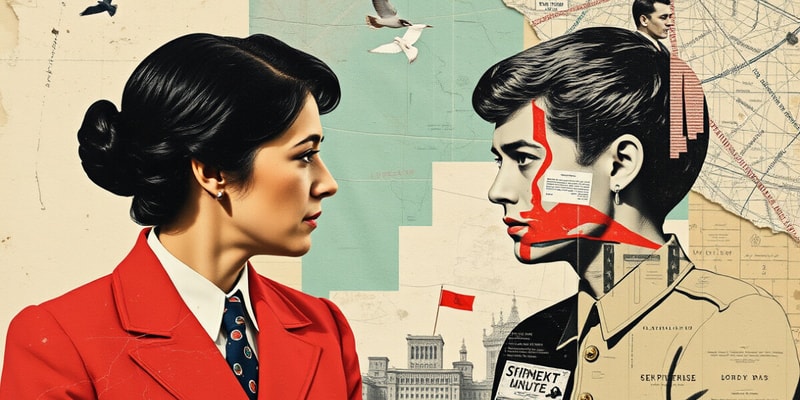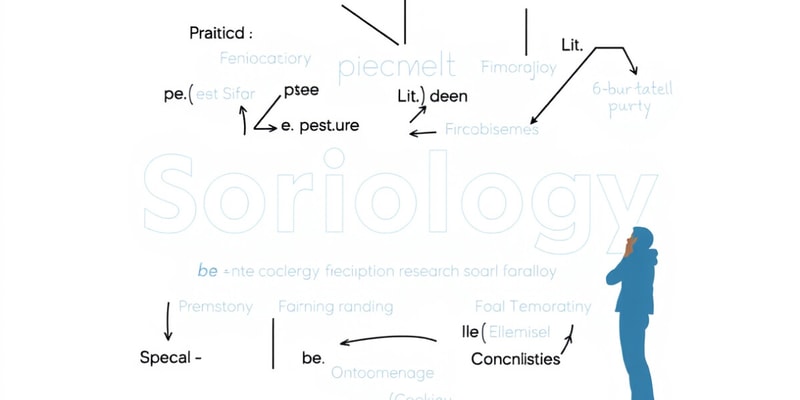Podcast
Questions and Answers
What characterizes a meritocracy in a workplace setting?
What characterizes a meritocracy in a workplace setting?
What does the concept of an instrumental function refer to in a group context?
What does the concept of an instrumental function refer to in a group context?
Why is a more formal social structure significant in group dynamics?
Why is a more formal social structure significant in group dynamics?
Which of the following best defines the term 'meritocracy'?
Which of the following best defines the term 'meritocracy'?
Signup and view all the answers
What aspect of group roles does a structure with instrumental functions emphasize?
What aspect of group roles does a structure with instrumental functions emphasize?
Signup and view all the answers
What defines a group in sociological terms?
What defines a group in sociological terms?
Signup and view all the answers
Which type of organization do people not voluntarily join?
Which type of organization do people not voluntarily join?
Signup and view all the answers
What is a characteristic feature of bureaucracies?
What is a characteristic feature of bureaucracies?
Signup and view all the answers
Which leader type is characterized by encouraging group participation?
Which leader type is characterized by encouraging group participation?
Signup and view all the answers
Which best describes the 'Iron Rule of Oligarchy'?
Which best describes the 'Iron Rule of Oligarchy'?
Signup and view all the answers
What term refers to organizations that people join for intangible rewards?
What term refers to organizations that people join for intangible rewards?
Signup and view all the answers
What does the term 'total institution' refer to?
What does the term 'total institution' refer to?
Signup and view all the answers
What type of leader focuses primarily on task accomplishment?
What type of leader focuses primarily on task accomplishment?
Signup and view all the answers
Which type of group is characterized as small and informal?
Which type of group is characterized as small and informal?
Signup and view all the answers
The term 'McDonaldization of Society' refers to what phenomenon?
The term 'McDonaldization of Society' refers to what phenomenon?
Signup and view all the answers
What type of group is characterized by small, long-term emotional interactions?
What type of group is characterized by small, long-term emotional interactions?
Signup and view all the answers
Which perspective focuses on analyzing how movements like MeToo confront institutional tolerance of harassment?
Which perspective focuses on analyzing how movements like MeToo confront institutional tolerance of harassment?
Signup and view all the answers
What defines an out-group?
What defines an out-group?
Signup and view all the answers
In group dynamics, what is the main characteristic of a triad?
In group dynamics, what is the main characteristic of a triad?
Signup and view all the answers
What leadership style is described as goal-oriented and focused on task completion?
What leadership style is described as goal-oriented and focused on task completion?
Signup and view all the answers
What occurs during the bystander effect?
What occurs during the bystander effect?
Signup and view all the answers
Which group type transforms from secondary to primary under certain conditions?
Which group type transforms from secondary to primary under certain conditions?
Signup and view all the answers
What does the term 'diffusion of responsibility' refer to in group dynamics?
What does the term 'diffusion of responsibility' refer to in group dynamics?
Signup and view all the answers
What is a key characteristic of bureaucracies as described by Max Weber?
What is a key characteristic of bureaucracies as described by Max Weber?
Signup and view all the answers
Which type of leadership style involves minimal intervention by leaders?
Which type of leadership style involves minimal intervention by leaders?
Signup and view all the answers
In the context of in-groups, what does 'group cohesion' refer to?
In the context of in-groups, what does 'group cohesion' refer to?
Signup and view all the answers
Which experiment demonstrated the effect of conformity among participants?
Which experiment demonstrated the effect of conformity among participants?
Signup and view all the answers
Which sociological perspective emphasizes the roles groups play in societal stability?
Which sociological perspective emphasizes the roles groups play in societal stability?
Signup and view all the answers
What is a primary function of reference groups?
What is a primary function of reference groups?
Signup and view all the answers
What does the McDonaldization of society entail?
What does the McDonaldization of society entail?
Signup and view all the answers
What distinguishes normative organizations from utilitarian organizations?
What distinguishes normative organizations from utilitarian organizations?
Signup and view all the answers
Which of the following is a characteristic of bureaucracies?
Which of the following is a characteristic of bureaucracies?
Signup and view all the answers
In what way does McDonaldization impact services in society?
In what way does McDonaldization impact services in society?
Signup and view all the answers
What potential negative effect is associated with the McDonaldization process?
What potential negative effect is associated with the McDonaldization process?
Signup and view all the answers
What is a primary criticism of bureaucracies according to Michels's theory?
What is a primary criticism of bureaucracies according to Michels's theory?
Signup and view all the answers
Which of the following best describes a coercive organization?
Which of the following best describes a coercive organization?
Signup and view all the answers
How can bias affect the concept of meritocracy in organizations?
How can bias affect the concept of meritocracy in organizations?
Signup and view all the answers
What is one of the main features of bureaucratic structures that enhances efficiency?
What is one of the main features of bureaucratic structures that enhances efficiency?
Signup and view all the answers
What defines utilitarian organizations?
What defines utilitarian organizations?
Signup and view all the answers
Which of the following accurately describes the concept of 'reference group'?
Which of the following accurately describes the concept of 'reference group'?
Signup and view all the answers
What is a likely impact of essentializing bureaucracy's strict rules?
What is a likely impact of essentializing bureaucracy's strict rules?
Signup and view all the answers
Which aspect of McDonaldization prioritizes quantifiable outcomes over quality?
Which aspect of McDonaldization prioritizes quantifiable outcomes over quality?
Signup and view all the answers
What does the term 'aggregate' refer to in sociological contexts?
What does the term 'aggregate' refer to in sociological contexts?
Signup and view all the answers
Which characteristic is least associated with impersonal relationships in bureaucracies?
Which characteristic is least associated with impersonal relationships in bureaucracies?
Signup and view all the answers
Study Notes
Key Terms
- Aggregate: A collection of individuals in the same place simultaneously, lacking interaction or shared identity.
- Authoritarian Leader: A directive leader who issues orders and assigns tasks without collaborative input.
- Bureaucracies: Structured organizations with a hierarchy of authority and explicit roles aimed at efficiency.
- Clear Division of Labor: Each bureaucratic member has specialized tasks, aiding efficiency.
- Coercive Organizations: Organizations individuals are compelled to join, such as prisons or mental health facilities.
- Conformity: The degree to which individuals align with group or societal expectations.
- Democratic Leader: A leader fostering group participation and collective decision-making.
- Dyad: The simplest group form, comprising two individuals.
- Explicit Rules: Documented and standardized regulations in a bureaucracy aimed at uniformity.
- Expressive Function: The emotional or supportive role a group serves for its members.
- Expressive Leader: A leader focused on emotional well-being and group process.
- Formal Organizations: Large, impersonal entities characterized by structured interactions.
- Group: At least two people who frequently interact and share an aligned identity.
- Hierarchy of Authority: An organized chain of command in bureaucracies.
- Impersonality: The professional detachment in relationships to prevent favoritism.
- In-Group: A group integral to an individual's identity.
- Instrumental Function: The task-oriented role aimed at achieving specific goals.
- Instrumental Leader: A leader focused primarily on accomplishing tasks efficiently.
- Iron Rule of Oligarchy: The idea that organizations are often dominated by a small elite.
- Laissez-Faire Leader: A hands-off leader allowing group autonomy in decision-making.
- Leadership Function: The core objective of a leader's role within a group.
- Leadership Style: The method a leader employs to motivate and guide group members.
- McDonaldization of Society: The spread of fast-food practices in various sectors of society.
- Meritocracy: A system where individuals advance based on ability and skills.
- Normative Organizations: Voluntary groups joined for shared interests and intangible rewards.
- Out-Group: A social group an individual does not belong to and may compete with.
- Primary Groups: Small, emotionally close groups vital for personal relationships.
- Reference Groups: Groups individuals look to for standards and norms.
- Secondary Groups: Larger, more impersonal groups focused on specific tasks or goals.
- Total Institution: Organizations that control all aspects of life, requiring total resocialization.
- Triad: A more stable three-member group with dynamics for potential conflict or alliances.
- Utilitarian Organizations: Groups formed for practical purposes, providing material benefits.
Types of Groups and Their Influence
- Groups influence various societal elements including culture, economy, and governance.
- Functionalist Perspective: Views groups as addressing social needs and stabilizing society through expressions of discontent.
- Conflict Perspective: Analyzes how movements tackle inequality and power, exemplified by the Tea Party and MeToo.
- Symbolic Interactionist Perspective: Focuses on everyday interactions and leadership within different movement contexts.
Group Size and Structure
- Dyad and Triad: Dyads are vulnerable to dissolution if one member leaves, while triads offer more stability.
- Small Groups: Foster strong cohesion with limited external influence; large groups increase collective impact but may lose cohesiveness.
Leadership Styles
- Instrumental Leadership: Task-focused and goal-oriented, ideal for structured environments.
- Expressive Leadership: Prioritizes emotional support and morale within the group.
- Democratic Leadership: Engages members in decision-making; can slow processes.
- Laissez-Faire Leadership: Minimal intervention leads to participant-managed decisions; may cause disorganization.
- Authoritarian Leadership: Effective for quick decisions but may alienate members.
Conformity and Group Dynamics
- Conformity: Pressure to align with group norms can influence individual decisions, as seen in Asch and Milgram's experiments.
- Bystander Effect: Individuals are less likely to take action in emergencies with others present, assuming someone else will intervene.
- Diffusion of Responsibility: As group size increases, individual accountability decreases.
Formal Organizations
-
Types of Organizations:
- Normative: Voluntary and based on shared interests, providing intangible benefits.
- Coercive: Compulsory membership, often in resocialization contexts.
- Utilitarian: Formed for tangible benefits, like jobs and education.
-
Characteristics of Bureaucracies:
- Hierarchy: Defined chain of command.
- Division of Labor: Specific roles enhancing efficiency.
- Explicit Rules: Standardized regulations for consistency.
- Impersonality: Professional detachment to ensure fairness.
McDonaldization
- Efficiency: Processes streamlined for speed.
- Predictability: Services standardized across locations.
- Calculability: Focus on measurable outcomes over quality.
- Control: Automation ensures consistent service delivery.
- Impact: Homogenizes products/services; efforts to restore uniqueness are emerging.
Challenges of Bureaucracies
- Rigidity: Resistance to change can hinder responsiveness.
- Oligarchy: Control by a small elite undermines democratic processes.
- Biases: Meritocratic ideals may overlook inherent biases, perpetuating inequalities.
Glossary
- Utilitarian: Related to practical benefits derived from organization membership.
- Bureaucracy: An administrative system governing large institutions, marked by hierarchies and rule-based operation.
- Meritocracy: A framework that rewards individuals based on their demonstrated abilities and achievements.
Studying That Suits You
Use AI to generate personalized quizzes and flashcards to suit your learning preferences.
Description
Dive into the key terms of Chapter 6 in Sociology. This quiz covers important concepts such as aggregate, authoritarian leader, and bureaucracies, helping you understand the foundational elements of social structures. Test your knowledge and reinforce your understanding of these essential terms.




